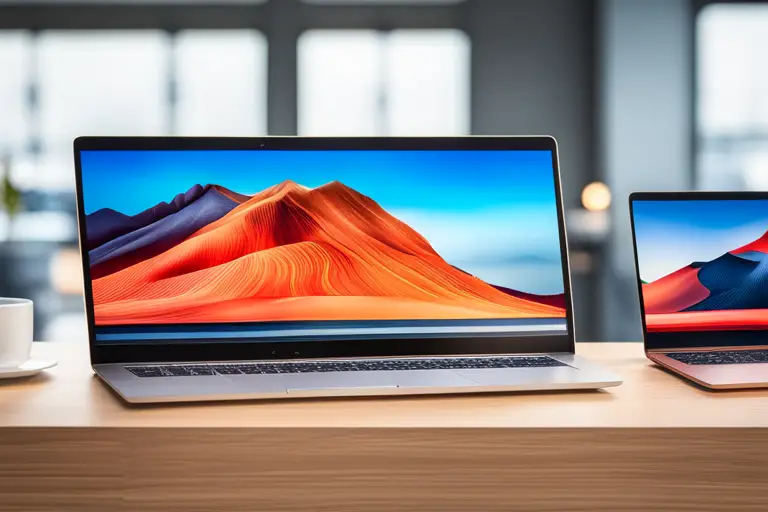Is your laptop running slower than usual? Are you experiencing longer loading times and laggy performance? Before you consider investing in a new device, try utilizing the built-in features to boost your laptop’s performance. With a few simple adjustments and tweaks, you can significantly improve your laptop’s speed and efficiency.
One of the easiest ways to enhance your laptop’s performance is by cleaning up your hard drive. Over time, your hard drive can become cluttered with unnecessary files and programs, which can slow down your system. By removing old files and programs, you can free up space, improve startup times, and optimize your laptop’s performance.
In this article, we’ll explore various built-in features that you can use to boost your laptop’s performance and get it running like new again.
Cleaning Up Your Hard Drive
You’ll want to start by taking a look at what’s on your hard drive and getting rid of any unnecessary files or programs. This will clear up space for your laptop to run more efficiently. One way to do this is by using the built-in Disk Cleanup tool on Windows. This tool will scan your hard drive for temporary files, system files, and other unnecessary files that can be safely deleted.
You can also uninstall programs that you no longer use or need through the Programs and Features section in the Control Panel. Another way to clean up your hard drive is by using a third-party software like CCleaner. This software can help you clean up your hard drive by removing junk files, temporary files, and other unnecessary files that can slow down your laptop’s performance.
It also has a registry cleaner feature that can help fix any issues with your registry, which can also improve your laptop’s performance. By cleaning up your hard drive, you can free up space and resources for your laptop to run more smoothly and efficiently.
Managing Your Startup Programs
To improve how quickly your laptop starts up, limit the number of programs that launch automatically when you turn on your device. Many programs are set to start automatically when you turn on your laptop, which can significantly slow down the startup process.
To manage your startup programs on Windows, go to the Task Manager and click on the Startup tab. Here, you can see which programs are set to launch automatically and disable any that you don’t need. It’s important to only disable programs that you’re sure you don’t need at startup, as disabling critical system programs can cause issues with your laptop. If you’re not sure what a program does, it’s best to leave it enabled.
On a Mac, you can manage your startup programs by going to System Preferences, then Users & Groups, and finally clicking on the Login Items tab. Again, be sure to only disable programs that you don’t need at startup to avoid any potential issues.
By managing your startup programs, you can significantly improve your laptop’s performance and startup time.
Disabling Unnecessary Background Processes
If your laptop seems to be running slower than usual, take a moment to check if there are any unnecessary background processes running that could be causing the issue. These processes are usually programs that run in the background and take up valuable system resources, ultimately slowing down your laptop.
To check which processes are running in the background, simply press Ctrl+Shift+Esc to open the Task Manager and click on the Processes tab. Once you have identified which processes are running unnecessarily, you can easily disable them.
To do this, simply right-click on the process and select End Task. However, be cautious when disabling processes as some are necessary for your laptop to function properly. It’s recommended to research each process before disabling it to ensure that it isn’t essential to your laptop’s performance.
By disabling unnecessary background processes, you can free up system resources and boost your laptop’s performance.
Updating Your Operating System and Drivers
Updating your operating system and drivers can significantly improve your device’s functionality and ensure it runs smoothly. To check for updates, go to your settings and look for the option to update your device. It’s recommended to always have the latest updates installed as they often include bug fixes, security patches, and new features that can improve performance.
Similarly, updating your drivers can also improve performance. Drivers are software programs that allow hardware devices to communicate with your operating system. Outdated drivers can cause issues such as slow performance, connectivity problems, and even system crashes. You can check for driver updates by going to your device manager and looking for any devices with a yellow exclamation mark next to them. Updating drivers can often be done automatically through your device manager or by going to the manufacturer’s website to download the latest version.
Adjusting Power Settings for Improved Battery Life
Maximizing your laptop’s battery life is crucial when you’re on the go. You can adjust your power settings to help achieve this.
One way to do this is by changing your power plan to a more battery-friendly option. This can easily be done by clicking on the battery icon on your taskbar and selecting ‘Power Options.’ From there, you can choose a power plan that suits your needs, such as ‘Power saver’ or ‘Balanced.’
Another way to improve your laptop’s battery life is by adjusting the screen brightness. The brighter your screen, the more power it consumes. By reducing the brightness, you can extend your battery life significantly. You can easily adjust the brightness by using the function keys on your keyboard or by going into the ‘Display Settings’ and manually adjusting the slider.
By making these simple adjustments to your power settings, you can get more out of your laptop’s battery life and stay productive on the go.
Running System Maintenance Tasks
Running regular system maintenance tasks can help keep your laptop running smoothly and prevent potential issues down the line. These tasks are built-in features that are designed to optimize your laptop’s performance and fix any problems that may arise.
One important system maintenance task is running a disk cleanup. This feature helps free up space on your hard drive by removing unnecessary files and temporary system files.
Another useful task is disk defragmentation, which rearranges fragmented data on your hard drive to improve access speed.
You should also regularly run a virus scan to ensure that your laptop is not infected with any harmful malware.
By performing these maintenance tasks, you can improve your laptop’s performance and extend its lifespan.
Utilizing Built-in Performance Optimization Tools
You can easily improve your laptop’s speed and responsiveness by taking advantage of its built-in performance optimization tools.
One such tool is the Disk Cleanup utility, which allows you to free up space on your hard drive by deleting unnecessary files and temporary internet files. To access this tool, simply go to your Start menu, search for ‘Disk Cleanup,’ and select the option to run the utility.
Another useful tool is the Disk Defragmenter, which reorganizes your hard drive to make it run more efficiently. Over time, files on your hard drive can become fragmented, meaning they are stored in different parts of the disk. This can slow down your computer, as it takes longer for the system to access the files it needs.
Running the Disk Defragmenter tool can help to solve this problem, and it’s easy to use. Simply go to your Start menu, search for ‘Disk Defragmenter,’ and select the option to run the utility.
By using these built-in performance optimization tools, you can keep your laptop running smoothly and avoid the need for costly upgrades or repairs.
Frequently Asked Questions
What are some common hardware upgrades that can improve laptop performance?
Upgrading the RAM and SSD are common hardware upgrades that can improve laptop performance. You can also replace the battery and upgrade the graphics card if necessary.
How can I troubleshoot and fix hardware issues that may be affecting my laptop’s performance?
To troubleshoot and fix hardware issues affecting your laptop’s performance, start by checking for any loose connections or damaged components. Consider seeking professional help if the issue persists.
What is the best way to monitor my laptop’s performance and identify any bottlenecks?
To monitor your laptop’s performance and identify bottlenecks, use the built-in Task Manager on Windows or Activity Monitor on Mac. Check CPU, memory, and disk usage to see what may be causing slowdowns.
Are there any software tools or utilities that can help boost laptop performance beyond the built-in features mentioned in the article?
Yes, there are various software tools and utilities available that can enhance your laptop’s performance beyond the built-in features. These include optimization software, registry cleaners, and driver updaters, among others.
How can I optimize my laptop’s performance for specific tasks, such as gaming or video editing?
To optimize your laptop’s performance for specific tasks like gaming or video editing, upgrade the RAM and graphics card, keep the laptop cool, close unnecessary apps, and use performance-enhancing software like Game Booster or Adobe Premiere Pro.
Conclusion
Congratulations! You’ve successfully learned how to boost your laptop’s performance using built-in features. By following the tips outlined in this article, you can improve speed, optimize battery life, and keep your laptop running smoothly.
Remember to regularly clean up your hard drive, manage your startup programs, and disable unnecessary background processes. Keep your operating system and drivers up to date, adjust your power settings, and run system maintenance tasks to keep your laptop in top shape.
And don’t forget to utilize the built-in performance optimization tools available to you.
By implementing these simple tips, you can make the most of your laptop’s capabilities and enjoy a faster, more efficient computing experience.
So why wait? Start boosting your laptop’s performance today!

Hey there, tech enthusiasts! I’m your go-to content writer, delving into the fascinating world of technology hacks. Get ready to unlock mind-blowing secrets and discover innovative solutions through my engaging and insightful blogs.


